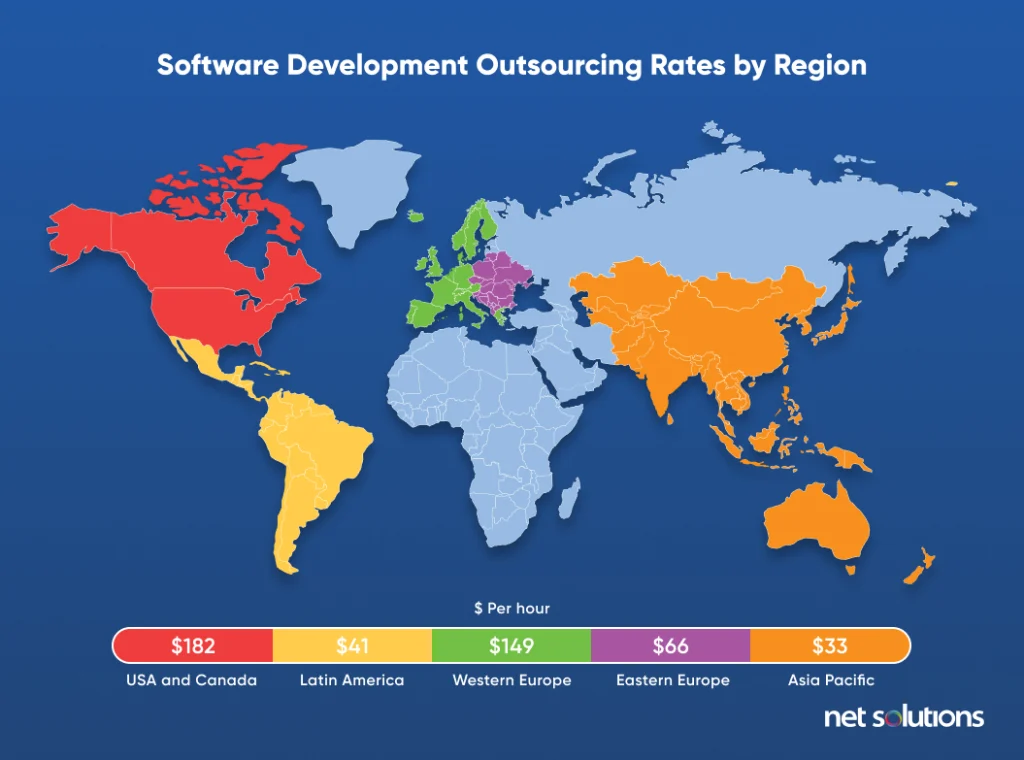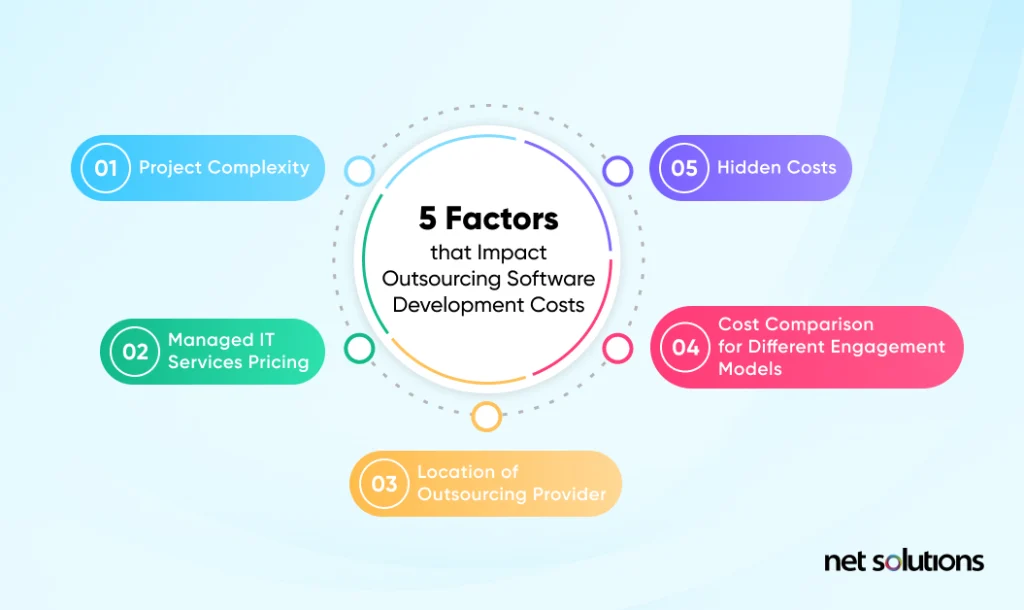Outsourcing can be a cost-effective way to produce quality software—assuming you hire a reputable, talented firm that can bring your vision to life.
Many companies turn to offshore development firms because, in addition to the efficiency and scalability that come with outsourcing in general, offshoring allows them to benefit from reduced labor costs.
How much does it cost to outsource software development to different regions?
We’ll cover that question in this guide, providing links to more extensive (country-by-country) resources. We’ll also explore which factors influence overall costs and key things you can do to experience even greater cost savings.
Software Development Outsourcing Rates by Region
One of the many benefits of working with an offshore software development firm is reducing custom software development costs, thanks to the cost of living differential between different countries and the associated savings in labor costs.
We’ve written extensively about the average software development rates by country, so be sure to visit that post to learn about the costs associated with popular outsourcing destinations across the globe. What you’ll find in this post is general pricing based on major world regions.
Keep in mind, you’ll find plenty of variation within a region, so it’s worth viewing the country-by-country comparison we linked above.

USA and Canada
The average cost of outsourcing software development to the United States and Canada is $182 per hour.
Outsourcing to these countries is often cost-prohibitive due to the fact that many software development firms are located in major tech hubs like San Francisco, New York, and British Columbia, where the cost of living is among the highest in the world. That’s why many companies headquartered in the U.S. and Canada turn to overseas developers.
Latin America
The average cost of outsourcing software development to Latin America is $41 per hour.
Latin America is quickly becoming a popular IT outsourcing destination, with countries like Mexico, Argentina, Chile, Brazil, and Panama showing tremendous promise. Costs are quite reasonable, and many of these countries have a decent rate of English fluency.
Asia Pacific
The average cost of outsourcing software development to the Asia Pacific region is $33 per hour when evaluating outsourcing hotspots.
The world’s largest continent has a wide range of software development rates, but when we focus on hotspots like India and Vietnam, you’ll find extremely competitive pricing. India in particular offers tremendous value due to its low cost of living, high level of English fluency, and large number of talented software engineers.
When working with software development companies in Asia, thoroughly vet providers to ensure that language barriers and cultural differences won’t get in the way.
Eastern Europe
The average cost of outsourcing software development to Eastern Europe is $66 per hour.
Eastern Europe has become an outsourcing hub, with lower hourly rates than Western European countries and a wide pool of talent. Countries like Poland, Ukraine, the Czech Republic, and Hungry have entered the world stage and they’re producing quality software.
On the downside, English fluency isn’t as widespread in these countries, and the average hourly rates are twice those of many countries in Asia.
Western Europe
The average cost of outsourcing software development to Western Europe is $149 per hour.
Western Europe is home to many talented development teams in places like Germany and the U.K., but as with North America, it can get expensive. Hiring developers in Western Europe can be more than twice the price of working with outsourcing companies in Eastern Europe and nearly five times as expensive as outsourcing development to places like India.
5 Factors that Impact Outsourcing Software Development Costs
Beyond the country of origin, other factors influence the overall costs of custom software development. Here are five factors that may impact the cost of outsourcing a software development project.
Naturally, location is a big factor—so we talk about location once more in this section—but we’ll also cover some additional factors that impact software development outsourcing costs. Some of them might surprise you!

1. Project complexity
Are you looking to build a straightforward eCommerce website without much customization? Instead, are you looking to build a powerful app or engage in a complex digital transformation?
As you may expect, project complexity is the largest factor influencing the cost of software development. Here are some items that can make a project more complex (and therefore raise the cost):
- Total number of screens users encounter
- Extensive User Experience (UX) research and design requirements
- Heavy customization and complex functionality
- Project management as part of the development service
- Heavy revisions
- Cross-platform development for mobile app and website app development
- Any other factors that expand the amount of work required in the development process
This is by no means an exhaustive list of project requirements that could increase the complexity and cost of software design and development, but it should give you a rough idea of what might impact costs.
How can you reduce costs related to project complexity? One of the best ways to reduce your total cost of development is to create a Minimum Viable Product (MVP), which incorporates key functionality and design fundamentals without adding all the bells and whistles users expect from a later version. We’ll talk more about MVPs below.
2. Managed IT services pricing
IT Outsourcing companies don’t just design, build, and test software—many provide IT services as well. Managed Service Providers (MSPs) can handle any of the following IT needs.
- Help desk (for both internal staff and external customers)
- Cyber security
- General IT support (e.g., application licensing, infrastructure management)
- Data management
- Anything else that enables companies to harness the power of technology
We’ve put together a guide to help you understand and navigate IT services costs, and it’s worth reviewing if you’re considering hiring an MSP since pricing models can be confusing. Be sure to visit the link above for more in-depth analysis and pricing estimates.
Common managed services pricing models include:
- Per-device pricing is common for tech support, where companies pay a monthly fee based on the number of devices that the MSP services (e.g., laptops, desktops, printers, mobile devices)
- Per-user pricing is another common approach, where companies are invoiced monthly based on their number of users, regardless of the number of devices each user accesses
- Tiered pricing is a flexible approach to pricing where MSPs bill their clients based on the overall amount of work they take on, allowing in-house teams to handle certain IT tasks while external team members handle others
- Pay-as-you-go pricing means the MSP charges an hourly rate each time they work on any given task (with negotiated rates for different projects)
As you can imagine, costs can vary widely based on the pricing model and the overall number of services you use.
3. Location of outsourcing provider
As we mentioned above, hiring an outsourcing partner overseas can offer a great deal of cost savings, and you can still achieve high-quality work, assuming you thoroughly vet potential partners. Once again, refer to the blog post we mentioned above to identify average hourly rates in a range of countries, from China to Canada.
Given the major cost break that comes from working with development teams in emergent economies, you may wonder why anyone would consider working with outsourcing partners in regions like Western Europe and North America, or those in fully developed countries like Australia.
We’ll give it to you straight. Even though we’re an outsourcing firm based in India, we know there can be challenges when working with some overseas developers. Common challenges include time zone differences, cultural and language barriers, and low-quality work—but you can easily overcome these challenges, and we’ll tell you how.
When working with an outsourcing partner overseas, read reviews of their work on Clutch.co, look for detailed case studies on their website, and interview them thoroughly to make sure there are no major language barriers. Also, make sure they’re willing to work within your time zone if that’s something you care about.
There’s no reason you can’t reap the rewards of hiring a software development team overseas, from cost savings to tapping into a huge talent pool. As long as you do your due diligence upfront and ask tough questions about cybersecurity, development methodologies, experience, and overall strategy, you can get quality work at a reasonable price.
4. Cost comparison for different engagement models
Outsourcing isn’t a one-size-fits-all solution. For example, a startup might hire a full-service outsourcing firm to handle everything from user research and project management to design, development, and testing. Meanwhile, an established company might hire an offshore or a nearshore team to augment its workforce.
Here are three outsourcing models that are commonly used in the IT industry: Full outsourcing, selective outsourcing, and hybrid outsourcing.
Full outsourcing: As the name implies, this involves hiring a full-service team to handle everything—forgoing an in-house development team.
While this might seem like an expensive option, it’s often more cost-effective than hiring an in-house team of programmers due to the hidden costs of hiring full-time staff. It’s also far more flexible and scalable.
Selective outsourcing: This approach allows you to hire specialists for very specific outsourcing services, such as Quality Assurance (QA) or User Experience (UX) design.
You can use your in-house team to handle project management and perhaps other aspects of development, while your outsourcing partner becomes an extension of your team. This is a great way to reduce software testing costs or costs of other essential steps in the development process.
Hybrid outsourcing: A hybrid outsourcing model involves deep collaboration between in-house teams and external dedicated teams, with both parties playing a role in strategy.
When exploring the prospect of working with a given partner, perform a cost-benefit analysis to determine which outsourcing model will work best for your business. This may change over time, and if it does, a skilled outsourcing partner can help you adapt.
5. Hidden costs
Outsourcing comes with a few hidden costs that you need to consider—mostly related to the labor involved in managing the relationship. For example, you’ll need legal staff to review your contracts, and you’ll have internal staff reviewing the outsourcing team’s work and collaborating to bring your vision to life.
These actions are sunk costs if they’re performed by salaried employees, but they still factor into your bottom line.
How Outsourcing Can Reduce Software Development Costs + 2 Ways to Keep Costs Low
Outsourcing tends to be a far more cost-effective option for building software products when compared to hiring in-house staff.
A number of factors come into play in terms of cost reduction, including:
- No overhead costs for outsourced employees, since hiring, onboarding, payroll, taxes, benefits, and everything else is paid by the outsourcing firm
- Reduced labor costs
- Specialized expertise
- Scalability and flexibility, with the option to add and reduce staff whenever required
In addition to cost savings, two ways to keep costs low include creating a Minimum Viable Product (MVP) when it makes sense and working with a dedicated team at an outsourcing firm.
Creating a Minimum Viable Product (MVP)
As mentioned above, a Minimum Viable Product (MVP) is a stripped-down version of the aspirational software product you may hope to build over time. It incorporates all the basic functionality required to solve a problem for your target audience so you can gather feedback.
Introducing an MVP is a cost-effective way to determine what your initial round of users think of your product and gather Voice of the Customer (VoC) feedback. Their feedback will inform your design and development efforts, allowing you to add the features your users want—without spending time and money developing what you think they’ll want.
Building dedicated teams
Working with a dedicated team at an outsourcing firm, regardless of the outsourcing model you’re using, can be highly cost-effective because that team will get to know your company, its standards, its products, and all points of contact at your organization.
Dedicated teams, much like in-house staff, fall into a rhythm when they work together. This allows them to grow more efficient over time, providing many of the benefits that come with an in-house team—minus the costs and long-term commitment.
Looking for a talented, affordable outsourcing partner?
Are you looking to hire an outsourcing firm to handle any portion of your software development project, digital transformation, or day-to-day IT management needs? Net Solutions has worked with world leaders like IMG and the Harvard Business Review, as well as countless startups over the past two decades.
We’ve built mobile and desktop apps, along with complex and powerful eCommerce websites, and we’ve helped companies like Euro Car Parts and American Golf modernize their applications with cutting-edge tech stacks and the latest digital capabilities.
SHARE THIS POST
Table of Contents
Related Resources
- 10 Key Benefits of Outsourcing Software Development
- 10 Common Software Outsourcing Challenges [With Solutions]
- 19 Best Software Development Outsourcing Companies in 2025
- Software Development Outsourcing: India's Top 11 Contenders
- Comparing Software Development Outsourcing Models: A Decision-Maker's Guide
- A Guide to Nearshore Software Development Outsourcing [2025]
- Outsourcing Software Development: Evaluating the Pros and Cons
- 15 Questions to Ask when Outsourcing Software Development
- Outsourcing Software Development for Startups [2025 Guide]
- 2025 Software Development Outsourcing Statistics: Trends, Insights & Predictions
- Software Development Outsourcing Trends

